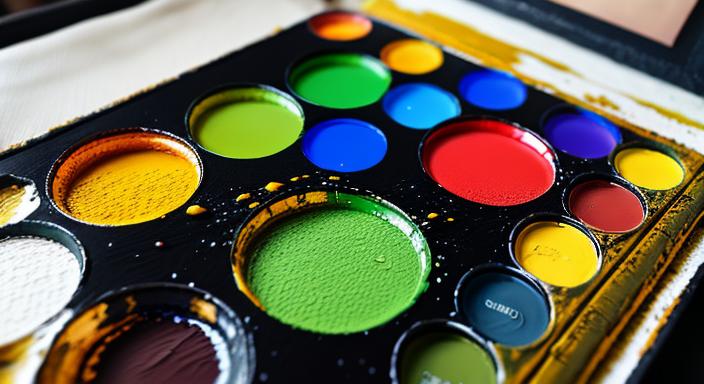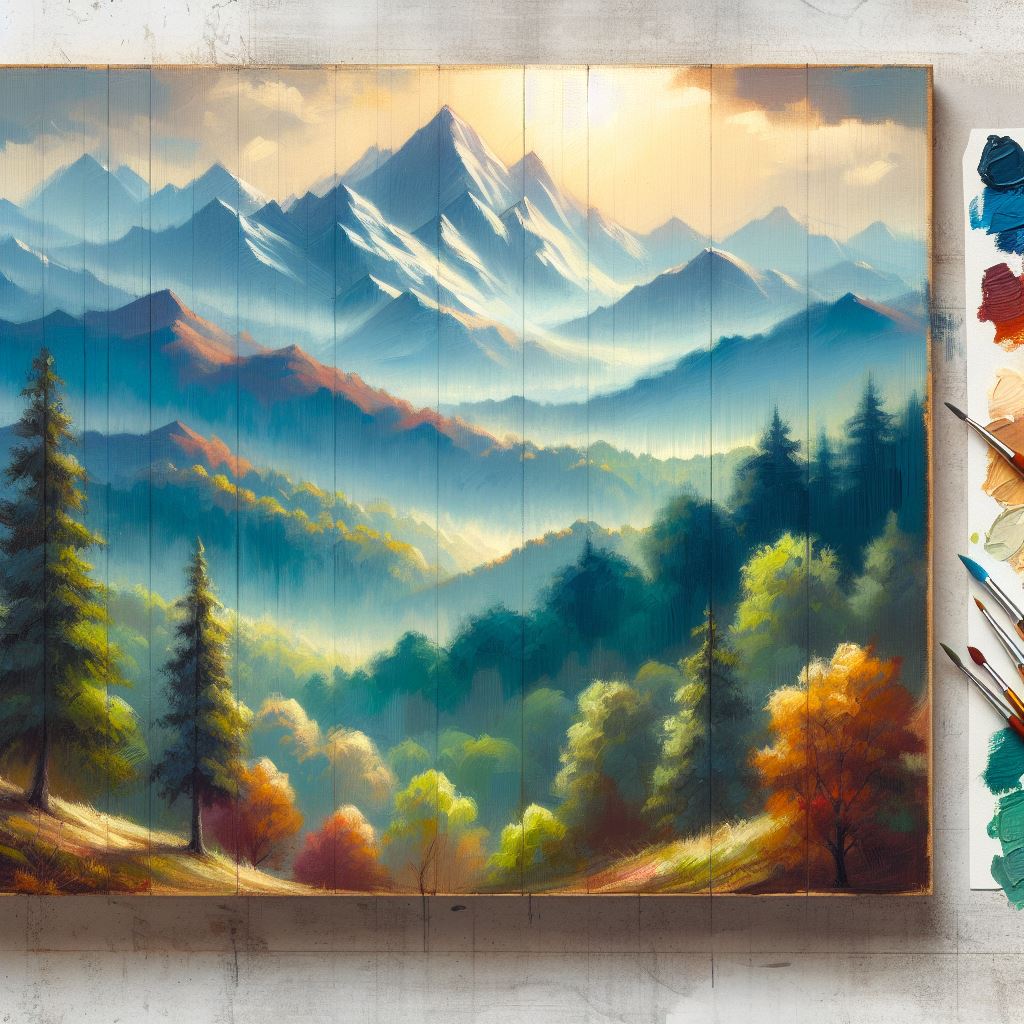Oil painting is a time-honored art form that has captivated artists and art enthusiasts for centuries. With its rich, velvety texture and ability to capture light and color, it’s no wonder that oil painting has remained a popular medium for expressing creativity and capturing the world around us. However, as with any artistic pursuit, there are risks involved, particularly when it comes to the materials used. In this comprehensive guide, we’ll explore the joy and tradition of oil painting, the components of oil paints, and the essential steps to creating a safe and sustainable oil painting practice.
| Safety Tip | Description |
|---|---|
| Choose Non-Toxic Paints and Mediums | Select oil paints, solvents, and mediums that are free from heavy metals and other harmful chemicals. Look for eco-friendly and “non-toxic” formulations. |
| Ensure Proper Ventilation | Improve air quality in your studio through the use of fans, open windows, or a dedicated ventilation system. Consider investing in a high-quality air purifier. |
| Utilize Personal Protective Equipment (PPE) | Wear gloves, masks, and eye protection to minimize skin and respiratory exposure to hazardous materials. |
| Implement Safe Disposal Practices | Properly dispose of used oil paints, solvents, and other hazardous waste according to local regulations. Dry out rags and paper towels before throwing them away. |
| Maintain Good Cleaning and Hygiene | Regularly wash your hands, clean your brushes, and dispose of used materials to reduce exposure to toxic substances. |
| Educate Yourself and Others | Stay informed about the latest developments in non-toxic oil painting practices and share your knowledge with fellow artists to promote a culture of safety. |
| Balance Safety and Creativity | Experiment with eco-friendly materials and techniques to find the right balance between your health, the environment, and your artistic expression. |
This comprehensive guide will explore these essential safety tips in detail, empowering you to create beautiful oil paintings while prioritizing your well-being and the health of our planet.
The Joy and Tradition of Oil Painting
Oil painting is a technique that involves using oil-based paints on canvas or other surfaces. The paint is made up of pigments, which provide color, and binders, which help the pigments adhere to the surface. Common binders include linseed oil, walnut oil, and poppy oil. These binders give oil paints their characteristic slow-drying time, allowing artists to blend and manipulate the paint for a long period.

Despite the beauty and versatility of oil painting, there have been concerns about the toxicity of the materials used. Some pigments contain heavy metals like lead, cadmium, and cobalt, which can be harmful if inhaled or ingested. Additionally, solvents like turpentine and mineral spirits, which are often used to thin and clean oil paints, can emit volatile organic compounds (VOCs) that can be hazardous to both the artist and the environment. These concerns have led to a growing interest in non-toxic oil painting practices.
Understanding Oil Paint Components
To better understand the concerns surrounding oil painting safety, it’s essential to know the components of oil paints and how they can affect our health. Oil paints are made up of pigments, which provide color, and binders, which help the pigments adhere to the surface. The binders are typically made from natural oils like linseed, walnut, or poppy oil. These oils are derived from plants and are generally considered safe for artists. However, some pigments used in oil paints can contain heavy metals, which can be harmful if inhaled or ingested.
There are a few misconceptions about the toxicity of oil paints that we should address. First, it’s important to note that not all oil paints are toxic. Many modern oil paints are made with non-toxic binders and pigments, and some manufacturers even offer “non-toxic” or “low-toxic” lines of oil paints. Second, the risks associated with oil painting are often exaggerated. While it’s true that some pigments and solvents can be hazardous, the risks can be minimized with proper handling and safety precautions.
Studio Safety Tips for Oil Painting
When it comes to oil painting safety, there are several essential tips to keep in mind to ensure a safe and healthy studio environment. Proper ventilation is crucial, as it helps to prevent the buildup of toxic fumes from solvents and paint. This can be achieved through the use of fans, open windows, or a ventilation system. HEPA air purifiers rated for chemicals are also a great option for workspaces where proper ventilation is difficult.
Wearing protective gear, such as gloves and eyewear, can help minimize skin exposure to oil painting mediums and solvents. On days when using a lot of thinner, the use of gloves is particularly important. Proper disposal of waste materials, such as rags and paper towels, is essential for fire safety. Always dry out rags and paper towels before disposing of them, as wet rags can oxidize over time and lead to potential fires.
Having close access to a sink with good soap is important for washing hands often when they get exposed to oil painting mediums and solvents. This helps to minimize skin exposure and maintain good hygiene. Skin exposure to oil painting mediums and solvents can carry certain risks, such as irritation, sensitization, and potentially more, depending on the specific materials involved. It is important to research the toxicity levels of each product, choose the best quality materials, and take appropriate precautions to minimize skin exposure whenever possible.
Fire Safety for Oil Painting
Fire safety is a crucial aspect of oil painting studio safety. With the use of flammable materials like oil paints, solvents, and thinners, it’s essential to take precautions to prevent fires. Flammable materials should be stored in a cool, well-ventilated area away from direct sunlight and heat sources. Having a fire extinguisher nearby and ensuring that everyone in the studio knows how to use it is a must. Smoke detectors and fire suppression systems can also help minimize damage in the event of a fire.
Regular fire safety training is crucial for everyone in the studio. Teach them how to use fire extinguishers, evacuation procedures, and how to respond in case of a fire. Ensure that there are clear emergency exits and evacuation plans in place, and conduct regular drills to familiarize everyone with the evacuation procedures. Keep a well-stocked first aid kit, fire blankets, and other fire safety equipment on hand, and regularly inspect and maintain this equipment to ensure it’s in good working order.
Eco-Friendly Oil Painting Practices
As an artist, it’s essential to consider the environmental impact of your oil painting practices. By adopting eco-friendly habits, you can create a healthier studio environment and reduce your carbon footprint. Choose non-toxic oil paints that are free from heavy metals and other harmful chemicals, and opt for natural solvents like walnut oil or alkyd mediums instead of traditional solvents like turpentine or mineral spirits.
Recycle your used paint cans, jars, and other materials whenever possible, and implement waste reduction techniques, such as using rags instead of paper towels, to minimize waste. Use energy-efficient lighting in your studio and consider installing a programmable thermostat to regulate temperature. Choose sustainable materials for your canvases, such as recycled or repurposed materials, and properly dispose of hazardous waste materials, such as used oil paints and solvents.
Stay informed about eco-friendly practices in the art world, and share your knowledge with others. Support companies that prioritize eco-friendly practices in their manufacturing processes, and collaborate with other artists to share knowledge and resources for eco-friendly oil painting practices. Incorporate eco-friendly themes and materials into your artwork to help raise awareness about environmental issues and inspire others to adopt eco-friendly practices.
The Benefits of Natural Solvents in Oil Painting
Traditional oil painting solvents like turpentine and mineral spirits are known to emit volatile organic compounds (VOCs), which can be harmful to both the artist and the environment. These solvents can cause respiratory issues, skin irritation, and even long-term health problems with prolonged exposure. Fortunately, there are several natural solvent alternatives that can be used in oil painting, including walnut oil, linseed oil, and alkyd mediums.
Using natural solvents in your oil painting practice offers several benefits. They are generally less toxic and emit fewer VOCs, reducing the risk of respiratory issues and other health problems. Natural solvents are derived from renewable, plant-based sources, making them a more eco-friendly choice. Many artists find that natural solvents offer a more pleasant and enjoyable painting experience, with a reduced odor and improved working properties. They can also be used for a variety of purposes, from thinning paint to cleaning brushes, making them a versatile addition to the oil painter’s toolkit.
Personal Protective Equipment (PPE) for Oil Painters
As oil painters, we’re exposed to a variety of materials that can be hazardous to our health if not handled properly. Personal protective equipment (PPE) is an essential tool for minimizing the risks associated with oil painting and ensuring a safe and healthy studio environment.
Wearing gloves made of nitrile or latex can provide a barrier against skin contact with oil paints, solvents, and other materials. Wearing a respirator or mask is important when working with powdered pigments or in poorly ventilated areas, and goggles or safety glasses can protect your eyes from splashes or airborne particles. You may also want to consider wearing a smock or apron to protect your clothing and skin from paint and solvent exposure.
Ensure that your PPE fits properly and is well-maintained. Replace worn or damaged items, and follow the manufacturer’s instructions for cleaning and storage. Make the use of PPE a regular part of your oil painting routine, and encourage everyone in your studio to prioritize their safety and health.
Creating a Non-Toxic Oil Painting Routine
By creating a non-toxic oil painting routine, we can minimize our exposure to hazardous materials and reduce our impact on the planet. One of the most important steps is to choose paints and mediums that are free from heavy metals and other harmful chemicals. Look for brands that prioritize eco-friendly and non-toxic formulations.
Proper storage and disposal of oil painting materials is crucial for maintaining a safe and healthy studio environment. Store flammable materials in a cool, well-ventilated area, and dispose of hazardous waste according to local regulations. Ensuring adequate ventilation in your studio is essential for reducing exposure to toxic fumes and particles, and the use of personal protective equipment is crucial for minimizing skin and respiratory exposure to hazardous materials.
Maintaining good cleaning and hygiene practices in your studio can also help reduce your exposure to toxic materials. Regularly wash your hands, clean your brushes, and dispose of used rags and paper towels properly. Stay informed about the latest developments in non-toxic oil painting practices and share your knowledge with other artists to help create a more sustainable and healthy art community.
Choosing Non-Toxic Paints and Mediums
One of the most important steps in creating a non-toxic oil painting routine is to choose paints and mediums that are free from heavy metals and other harmful chemicals. Look for brands that prioritize eco-friendly and non-toxic formulations.
Many modern oil paint manufacturers now offer “non-toxic” or “low-toxic” lines of paints that use safer pigments and binders. These paints can provide the same rich, vibrant colors as traditional oil paints without the associated health risks. When selecting your materials, be sure to read the labels carefully and research the specific ingredients to ensure you’re making an informed choice.
In addition to non-toxic paints, consider using natural solvents like walnut oil or alkyd mediums instead of traditional solvents like turpentine or mineral spirits. These alternatives are less toxic and produce fewer volatile organic compounds (VOCs), making them a more environmentally friendly option.
Proper Storage and Disposal
Proper storage and disposal of oil painting materials is crucial for maintaining a safe and healthy studio environment. Flammable materials like oil paints, solvents, and thinners should be stored in a cool, well-ventilated area, away from direct sunlight and heat sources.
When it comes to disposal, it’s important to follow local regulations for hazardous waste. Many cities and municipalities have specialized facilities that can safely dispose of used oil paints, solvents, and other potentially harmful materials. Avoid pouring these substances down the drain or throwing them in the trash, as this can have serious environmental consequences.
For non-hazardous waste, such as used rags and paper towels, be sure to properly dry them out before disposing of them. Wet rags can pose a fire risk due to the potential for spontaneous combustion.
Ventilation and Air Quality
Ensuring adequate ventilation in your studio is essential for reducing exposure to toxic fumes and particles. Consider investing in a high-quality air purifier or installing a dedicated ventilation system to improve the air quality in your workspace.
Good ventilation not only helps to remove harmful substances from the air but can also create a more comfortable and productive painting environment. Proper airflow can help to regulate temperature, reduce odors, and prevent the buildup of dust and other airborne particles.
In addition to mechanical ventilation, be mindful of the natural airflow in your studio. Open windows and doors when possible to encourage cross-ventilation and promote the circulation of fresh air.
Educating Yourself and Others
Staying informed about the latest developments in non-toxic oil painting practices and sharing your knowledge with other artists can help create a more sustainable and healthy art community.
Attend workshops, read industry publications, and connect with fellow painters to learn about new materials, techniques, and safety protocols. Share what you’ve learned with your studio mates, students, or local art groups to help spread awareness and encourage the adoption of safer practices.
By working together, we can elevate the standards of oil painting safety and inspire others to prioritize their health and the environment. Remember, small changes can make a big difference, so start implementing these practices today and encourage your fellow artists to do the same.
Creating a non-toxic oil painting routine is not just about individual actions – it’s also about building a supportive community of artists who are committed to safe and sustainable practices.
Collaborate with other painters in your studio or local art community to share knowledge, resources, and best practices. Organize workshops, panel discussions, or social events that focus on oil painting safety and eco-friendly techniques. By working together, you can create a network of artists who can learn from each other and inspire one another to adopt safer and more sustainable practices.
Additionally, consider reaching out to art supply retailers, manufacturers, and industry organizations to advocate for the development and promotion of non-toxic oil painting materials. Your voice and support can help drive the demand for safer and more environmentally friendly products, ultimately benefiting the entire art community.
Conclusion: Embracing the Future of Oil Painting
As we’ve explored throughout this comprehensive guide, oil painting is a beautiful and time-honored art form that can be enjoyed safely and sustainably. By understanding the components of oil paints, implementing safe studio practices, and embracing non-toxic alternatives, we can create a healthier and more eco-friendly oil painting experience.
The future of oil painting is bright, with a growing emphasis on safety, sustainability, and creative expression. By prioritizing our health and the environment, we can continue to push the boundaries of this medium and create works of art that inspire and captivate.
Remember, the key to mastering oil painting safety is to approach it with a balance of knowledge, diligence, and a willingness to experiment. Embrace the non-toxic alternatives, prioritize your studio setup, and let your creativity flow in a safe and sustainable manner. Together, we can elevate the art of oil painting to new heights, where beauty and responsibility go hand in hand.
So, as you embark on your next oil painting adventure, keep these essential tips in mind and let your passion for the medium shine through. With a commitment to safety and a dedication to your craft, the possibilities are endless.

